Cross-Cultural Management Report: Issues in HG Organization, Tanzania
VerifiedAdded on 2023/01/09
|10
|3021
|35
Report
AI Summary
This report provides a comprehensive analysis of a cross-cultural management case study involving the US-based organization, HG (Hydro Generation), and its dam project in Tanzania, Africa. The report identifies key issues such as high employee turnover, cultural clashes with local tribal rituals, and damage to the organization's global image. It delves into the impact of national culture, utilizing Hofstede's cultural dimensions theory to explain cultural differences and their effect on operations. The report further examines communication and negotiation challenges, including the lack of effective communication between the manager and local employees, as well as the headquarters. It also explores motivation and HRM strategies, referencing Maslow's hierarchy of needs, Herzberg's two-factor theory, and other relevant HRM theories. The report concludes with recommendations for addressing these issues and improving cross-cultural management practices within the organization.

CROSS CULTURAL
MANAGEMENT
MANAGEMENT
Secure Best Marks with AI Grader
Need help grading? Try our AI Grader for instant feedback on your assignments.
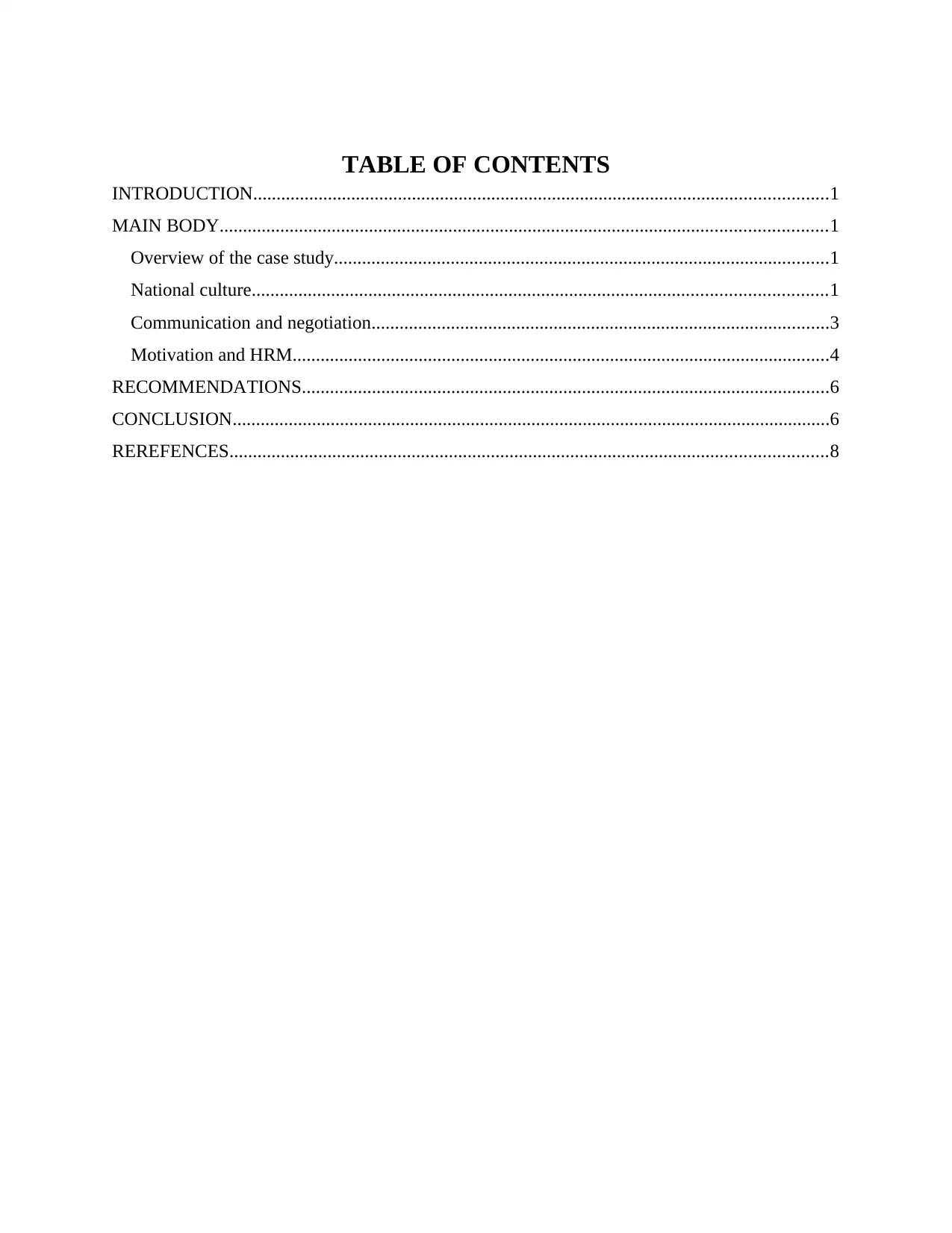
TABLE OF CONTENTS
INTRODUCTION...........................................................................................................................1
MAIN BODY..................................................................................................................................1
Overview of the case study..........................................................................................................1
National culture...........................................................................................................................1
Communication and negotiation..................................................................................................3
Motivation and HRM...................................................................................................................4
RECOMMENDATIONS.................................................................................................................6
CONCLUSION................................................................................................................................6
REREFENCES................................................................................................................................8
INTRODUCTION...........................................................................................................................1
MAIN BODY..................................................................................................................................1
Overview of the case study..........................................................................................................1
National culture...........................................................................................................................1
Communication and negotiation..................................................................................................3
Motivation and HRM...................................................................................................................4
RECOMMENDATIONS.................................................................................................................6
CONCLUSION................................................................................................................................6
REREFENCES................................................................................................................................8
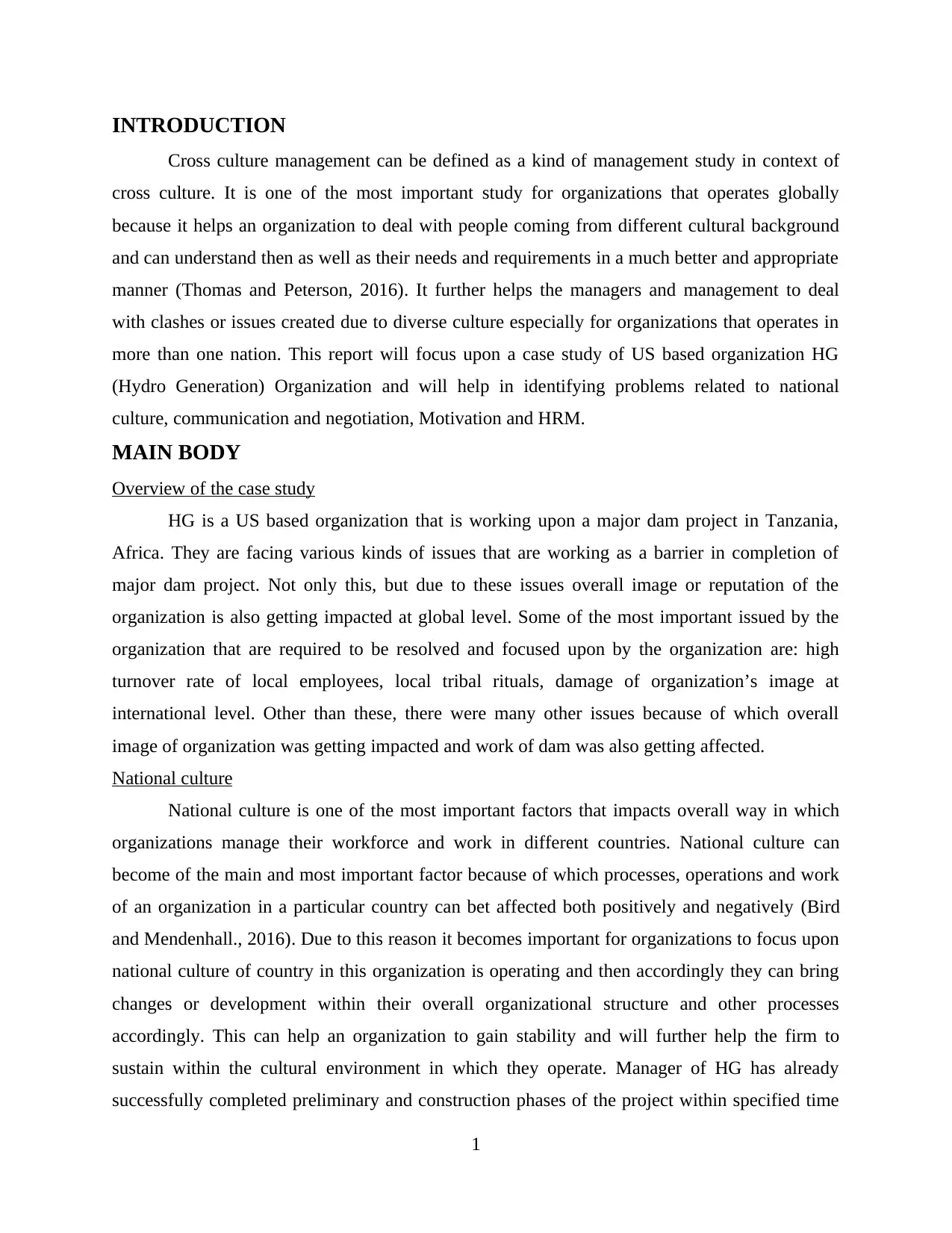
INTRODUCTION
Cross culture management can be defined as a kind of management study in context of
cross culture. It is one of the most important study for organizations that operates globally
because it helps an organization to deal with people coming from different cultural background
and can understand then as well as their needs and requirements in a much better and appropriate
manner (Thomas and Peterson, 2016). It further helps the managers and management to deal
with clashes or issues created due to diverse culture especially for organizations that operates in
more than one nation. This report will focus upon a case study of US based organization HG
(Hydro Generation) Organization and will help in identifying problems related to national
culture, communication and negotiation, Motivation and HRM.
MAIN BODY
Overview of the case study
HG is a US based organization that is working upon a major dam project in Tanzania,
Africa. They are facing various kinds of issues that are working as a barrier in completion of
major dam project. Not only this, but due to these issues overall image or reputation of the
organization is also getting impacted at global level. Some of the most important issued by the
organization that are required to be resolved and focused upon by the organization are: high
turnover rate of local employees, local tribal rituals, damage of organization’s image at
international level. Other than these, there were many other issues because of which overall
image of organization was getting impacted and work of dam was also getting affected.
National culture
National culture is one of the most important factors that impacts overall way in which
organizations manage their workforce and work in different countries. National culture can
become of the main and most important factor because of which processes, operations and work
of an organization in a particular country can bet affected both positively and negatively (Bird
and Mendenhall., 2016). Due to this reason it becomes important for organizations to focus upon
national culture of country in this organization is operating and then accordingly they can bring
changes or development within their overall organizational structure and other processes
accordingly. This can help an organization to gain stability and will further help the firm to
sustain within the cultural environment in which they operate. Manager of HG has already
successfully completed preliminary and construction phases of the project within specified time
1
Cross culture management can be defined as a kind of management study in context of
cross culture. It is one of the most important study for organizations that operates globally
because it helps an organization to deal with people coming from different cultural background
and can understand then as well as their needs and requirements in a much better and appropriate
manner (Thomas and Peterson, 2016). It further helps the managers and management to deal
with clashes or issues created due to diverse culture especially for organizations that operates in
more than one nation. This report will focus upon a case study of US based organization HG
(Hydro Generation) Organization and will help in identifying problems related to national
culture, communication and negotiation, Motivation and HRM.
MAIN BODY
Overview of the case study
HG is a US based organization that is working upon a major dam project in Tanzania,
Africa. They are facing various kinds of issues that are working as a barrier in completion of
major dam project. Not only this, but due to these issues overall image or reputation of the
organization is also getting impacted at global level. Some of the most important issued by the
organization that are required to be resolved and focused upon by the organization are: high
turnover rate of local employees, local tribal rituals, damage of organization’s image at
international level. Other than these, there were many other issues because of which overall
image of organization was getting impacted and work of dam was also getting affected.
National culture
National culture is one of the most important factors that impacts overall way in which
organizations manage their workforce and work in different countries. National culture can
become of the main and most important factor because of which processes, operations and work
of an organization in a particular country can bet affected both positively and negatively (Bird
and Mendenhall., 2016). Due to this reason it becomes important for organizations to focus upon
national culture of country in this organization is operating and then accordingly they can bring
changes or development within their overall organizational structure and other processes
accordingly. This can help an organization to gain stability and will further help the firm to
sustain within the cultural environment in which they operate. Manager of HG has already
successfully completed preliminary and construction phases of the project within specified time
1
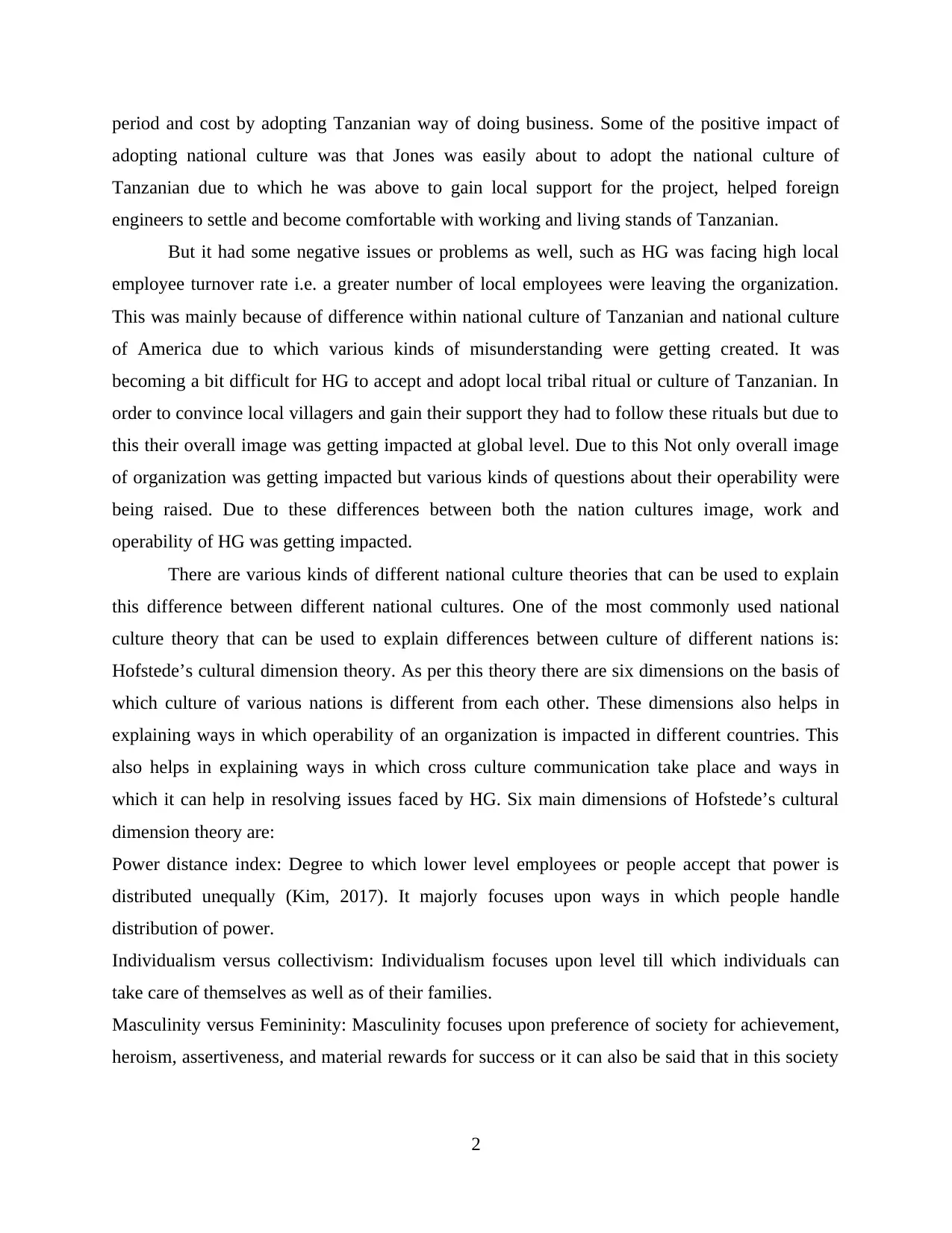
period and cost by adopting Tanzanian way of doing business. Some of the positive impact of
adopting national culture was that Jones was easily about to adopt the national culture of
Tanzanian due to which he was above to gain local support for the project, helped foreign
engineers to settle and become comfortable with working and living stands of Tanzanian.
But it had some negative issues or problems as well, such as HG was facing high local
employee turnover rate i.e. a greater number of local employees were leaving the organization.
This was mainly because of difference within national culture of Tanzanian and national culture
of America due to which various kinds of misunderstanding were getting created. It was
becoming a bit difficult for HG to accept and adopt local tribal ritual or culture of Tanzanian. In
order to convince local villagers and gain their support they had to follow these rituals but due to
this their overall image was getting impacted at global level. Due to this Not only overall image
of organization was getting impacted but various kinds of questions about their operability were
being raised. Due to these differences between both the nation cultures image, work and
operability of HG was getting impacted.
There are various kinds of different national culture theories that can be used to explain
this difference between different national cultures. One of the most commonly used national
culture theory that can be used to explain differences between culture of different nations is:
Hofstede’s cultural dimension theory. As per this theory there are six dimensions on the basis of
which culture of various nations is different from each other. These dimensions also helps in
explaining ways in which operability of an organization is impacted in different countries. This
also helps in explaining ways in which cross culture communication take place and ways in
which it can help in resolving issues faced by HG. Six main dimensions of Hofstede’s cultural
dimension theory are:
Power distance index: Degree to which lower level employees or people accept that power is
distributed unequally (Kim, 2017). It majorly focuses upon ways in which people handle
distribution of power.
Individualism versus collectivism: Individualism focuses upon level till which individuals can
take care of themselves as well as of their families.
Masculinity versus Femininity: Masculinity focuses upon preference of society for achievement,
heroism, assertiveness, and material rewards for success or it can also be said that in this society
2
adopting national culture was that Jones was easily about to adopt the national culture of
Tanzanian due to which he was above to gain local support for the project, helped foreign
engineers to settle and become comfortable with working and living stands of Tanzanian.
But it had some negative issues or problems as well, such as HG was facing high local
employee turnover rate i.e. a greater number of local employees were leaving the organization.
This was mainly because of difference within national culture of Tanzanian and national culture
of America due to which various kinds of misunderstanding were getting created. It was
becoming a bit difficult for HG to accept and adopt local tribal ritual or culture of Tanzanian. In
order to convince local villagers and gain their support they had to follow these rituals but due to
this their overall image was getting impacted at global level. Due to this Not only overall image
of organization was getting impacted but various kinds of questions about their operability were
being raised. Due to these differences between both the nation cultures image, work and
operability of HG was getting impacted.
There are various kinds of different national culture theories that can be used to explain
this difference between different national cultures. One of the most commonly used national
culture theory that can be used to explain differences between culture of different nations is:
Hofstede’s cultural dimension theory. As per this theory there are six dimensions on the basis of
which culture of various nations is different from each other. These dimensions also helps in
explaining ways in which operability of an organization is impacted in different countries. This
also helps in explaining ways in which cross culture communication take place and ways in
which it can help in resolving issues faced by HG. Six main dimensions of Hofstede’s cultural
dimension theory are:
Power distance index: Degree to which lower level employees or people accept that power is
distributed unequally (Kim, 2017). It majorly focuses upon ways in which people handle
distribution of power.
Individualism versus collectivism: Individualism focuses upon level till which individuals can
take care of themselves as well as of their families.
Masculinity versus Femininity: Masculinity focuses upon preference of society for achievement,
heroism, assertiveness, and material rewards for success or it can also be said that in this society
2
Secure Best Marks with AI Grader
Need help grading? Try our AI Grader for instant feedback on your assignments.
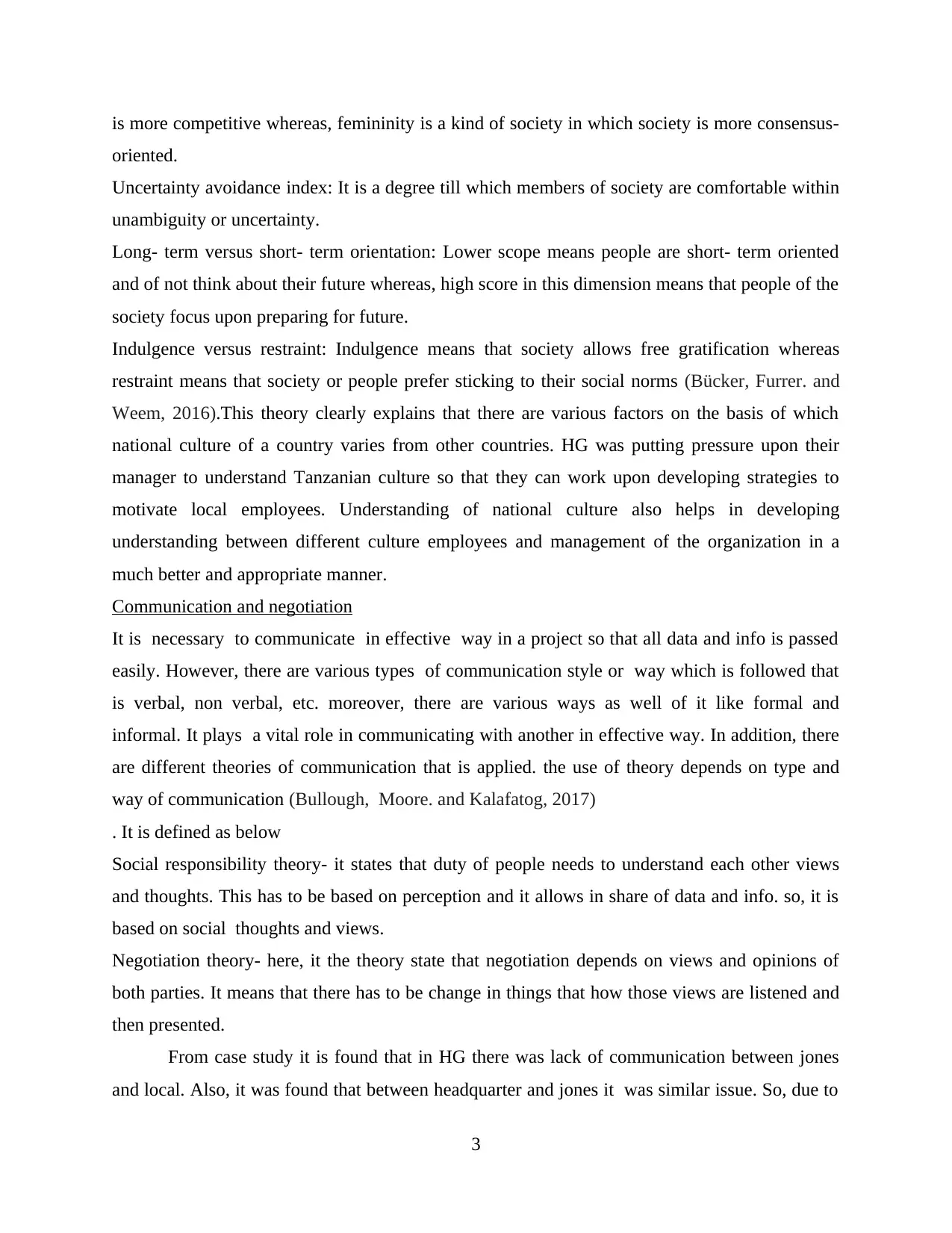
is more competitive whereas, femininity is a kind of society in which society is more consensus-
oriented.
Uncertainty avoidance index: It is a degree till which members of society are comfortable within
unambiguity or uncertainty.
Long- term versus short- term orientation: Lower scope means people are short- term oriented
and of not think about their future whereas, high score in this dimension means that people of the
society focus upon preparing for future.
Indulgence versus restraint: Indulgence means that society allows free gratification whereas
restraint means that society or people prefer sticking to their social norms (Bücker, Furrer. and
Weem, 2016).This theory clearly explains that there are various factors on the basis of which
national culture of a country varies from other countries. HG was putting pressure upon their
manager to understand Tanzanian culture so that they can work upon developing strategies to
motivate local employees. Understanding of national culture also helps in developing
understanding between different culture employees and management of the organization in a
much better and appropriate manner.
Communication and negotiation
It is necessary to communicate in effective way in a project so that all data and info is passed
easily. However, there are various types of communication style or way which is followed that
is verbal, non verbal, etc. moreover, there are various ways as well of it like formal and
informal. It plays a vital role in communicating with another in effective way. In addition, there
are different theories of communication that is applied. the use of theory depends on type and
way of communication (Bullough, Moore. and Kalafatog, 2017)
. It is defined as below
Social responsibility theory- it states that duty of people needs to understand each other views
and thoughts. This has to be based on perception and it allows in share of data and info. so, it is
based on social thoughts and views.
Negotiation theory- here, it the theory state that negotiation depends on views and opinions of
both parties. It means that there has to be change in things that how those views are listened and
then presented.
From case study it is found that in HG there was lack of communication between jones
and local. Also, it was found that between headquarter and jones it was similar issue. So, due to
3
oriented.
Uncertainty avoidance index: It is a degree till which members of society are comfortable within
unambiguity or uncertainty.
Long- term versus short- term orientation: Lower scope means people are short- term oriented
and of not think about their future whereas, high score in this dimension means that people of the
society focus upon preparing for future.
Indulgence versus restraint: Indulgence means that society allows free gratification whereas
restraint means that society or people prefer sticking to their social norms (Bücker, Furrer. and
Weem, 2016).This theory clearly explains that there are various factors on the basis of which
national culture of a country varies from other countries. HG was putting pressure upon their
manager to understand Tanzanian culture so that they can work upon developing strategies to
motivate local employees. Understanding of national culture also helps in developing
understanding between different culture employees and management of the organization in a
much better and appropriate manner.
Communication and negotiation
It is necessary to communicate in effective way in a project so that all data and info is passed
easily. However, there are various types of communication style or way which is followed that
is verbal, non verbal, etc. moreover, there are various ways as well of it like formal and
informal. It plays a vital role in communicating with another in effective way. In addition, there
are different theories of communication that is applied. the use of theory depends on type and
way of communication (Bullough, Moore. and Kalafatog, 2017)
. It is defined as below
Social responsibility theory- it states that duty of people needs to understand each other views
and thoughts. This has to be based on perception and it allows in share of data and info. so, it is
based on social thoughts and views.
Negotiation theory- here, it the theory state that negotiation depends on views and opinions of
both parties. It means that there has to be change in things that how those views are listened and
then presented.
From case study it is found that in HG there was lack of communication between jones
and local. Also, it was found that between headquarter and jones it was similar issue. So, due to
3
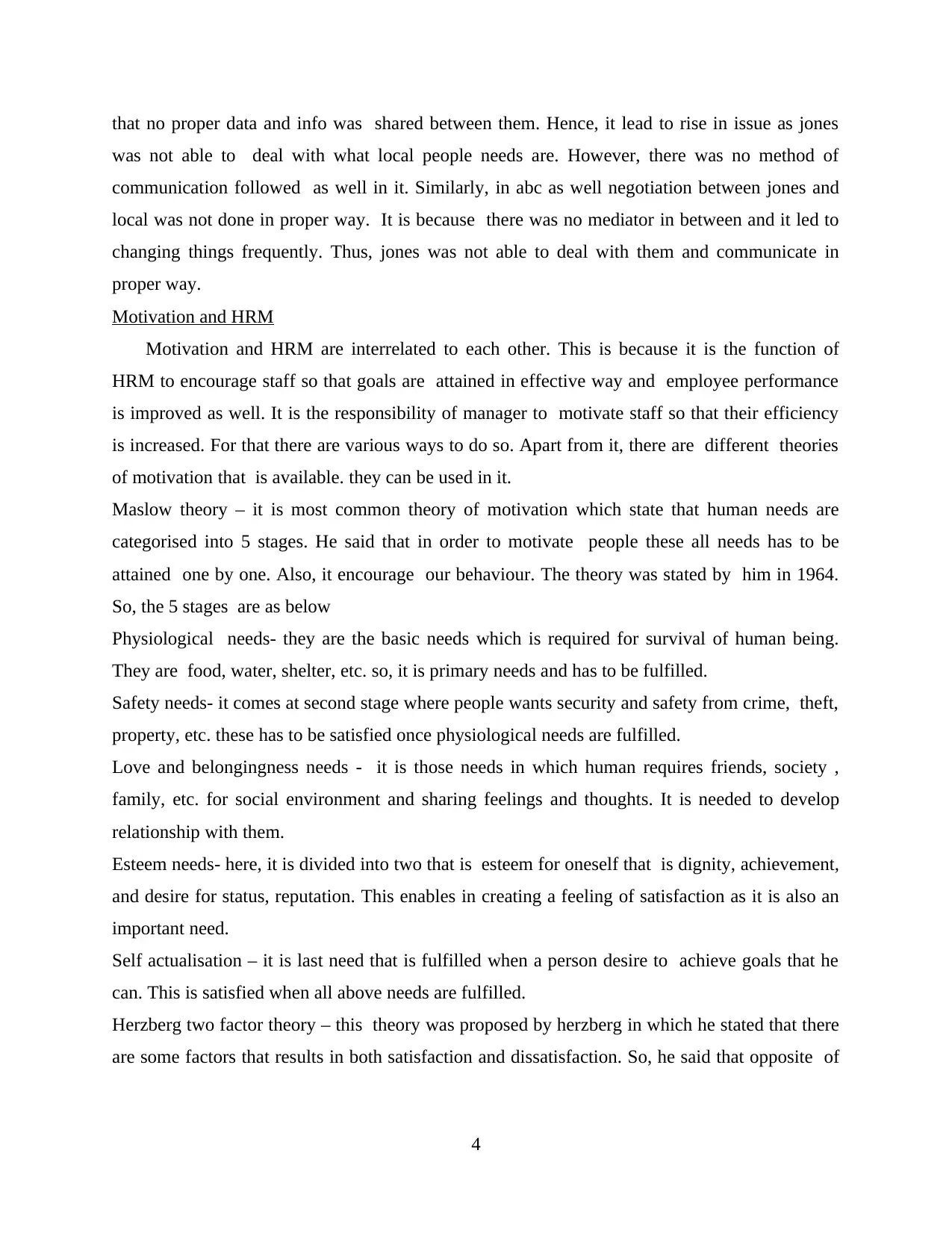
that no proper data and info was shared between them. Hence, it lead to rise in issue as jones
was not able to deal with what local people needs are. However, there was no method of
communication followed as well in it. Similarly, in abc as well negotiation between jones and
local was not done in proper way. It is because there was no mediator in between and it led to
changing things frequently. Thus, jones was not able to deal with them and communicate in
proper way.
Motivation and HRM
Motivation and HRM are interrelated to each other. This is because it is the function of
HRM to encourage staff so that goals are attained in effective way and employee performance
is improved as well. It is the responsibility of manager to motivate staff so that their efficiency
is increased. For that there are various ways to do so. Apart from it, there are different theories
of motivation that is available. they can be used in it.
Maslow theory – it is most common theory of motivation which state that human needs are
categorised into 5 stages. He said that in order to motivate people these all needs has to be
attained one by one. Also, it encourage our behaviour. The theory was stated by him in 1964.
So, the 5 stages are as below
Physiological needs- they are the basic needs which is required for survival of human being.
They are food, water, shelter, etc. so, it is primary needs and has to be fulfilled.
Safety needs- it comes at second stage where people wants security and safety from crime, theft,
property, etc. these has to be satisfied once physiological needs are fulfilled.
Love and belongingness needs - it is those needs in which human requires friends, society ,
family, etc. for social environment and sharing feelings and thoughts. It is needed to develop
relationship with them.
Esteem needs- here, it is divided into two that is esteem for oneself that is dignity, achievement,
and desire for status, reputation. This enables in creating a feeling of satisfaction as it is also an
important need.
Self actualisation – it is last need that is fulfilled when a person desire to achieve goals that he
can. This is satisfied when all above needs are fulfilled.
Herzberg two factor theory – this theory was proposed by herzberg in which he stated that there
are some factors that results in both satisfaction and dissatisfaction. So, he said that opposite of
4
was not able to deal with what local people needs are. However, there was no method of
communication followed as well in it. Similarly, in abc as well negotiation between jones and
local was not done in proper way. It is because there was no mediator in between and it led to
changing things frequently. Thus, jones was not able to deal with them and communicate in
proper way.
Motivation and HRM
Motivation and HRM are interrelated to each other. This is because it is the function of
HRM to encourage staff so that goals are attained in effective way and employee performance
is improved as well. It is the responsibility of manager to motivate staff so that their efficiency
is increased. For that there are various ways to do so. Apart from it, there are different theories
of motivation that is available. they can be used in it.
Maslow theory – it is most common theory of motivation which state that human needs are
categorised into 5 stages. He said that in order to motivate people these all needs has to be
attained one by one. Also, it encourage our behaviour. The theory was stated by him in 1964.
So, the 5 stages are as below
Physiological needs- they are the basic needs which is required for survival of human being.
They are food, water, shelter, etc. so, it is primary needs and has to be fulfilled.
Safety needs- it comes at second stage where people wants security and safety from crime, theft,
property, etc. these has to be satisfied once physiological needs are fulfilled.
Love and belongingness needs - it is those needs in which human requires friends, society ,
family, etc. for social environment and sharing feelings and thoughts. It is needed to develop
relationship with them.
Esteem needs- here, it is divided into two that is esteem for oneself that is dignity, achievement,
and desire for status, reputation. This enables in creating a feeling of satisfaction as it is also an
important need.
Self actualisation – it is last need that is fulfilled when a person desire to achieve goals that he
can. This is satisfied when all above needs are fulfilled.
Herzberg two factor theory – this theory was proposed by herzberg in which he stated that there
are some factors that results in both satisfaction and dissatisfaction. So, he said that opposite of
4
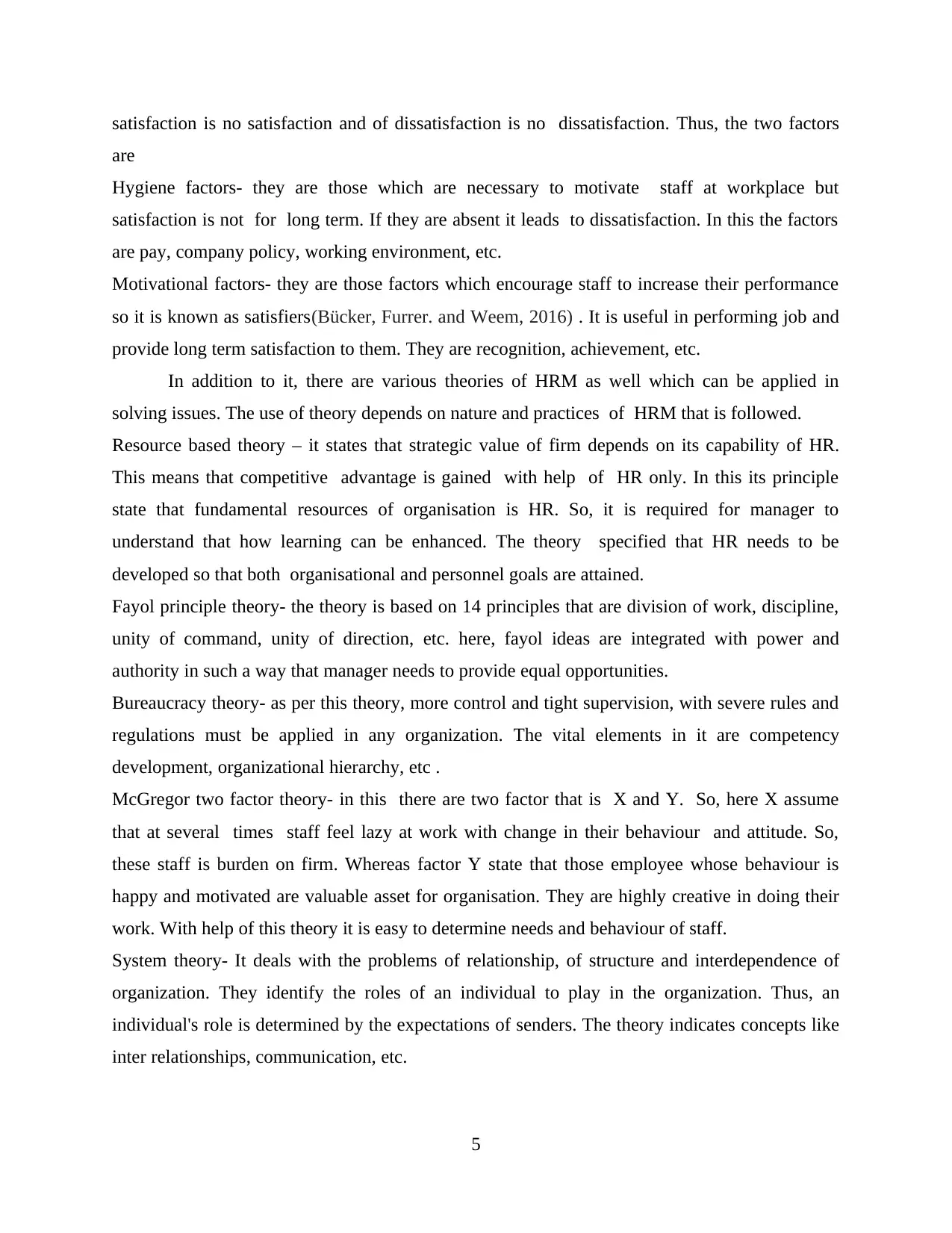
satisfaction is no satisfaction and of dissatisfaction is no dissatisfaction. Thus, the two factors
are
Hygiene factors- they are those which are necessary to motivate staff at workplace but
satisfaction is not for long term. If they are absent it leads to dissatisfaction. In this the factors
are pay, company policy, working environment, etc.
Motivational factors- they are those factors which encourage staff to increase their performance
so it is known as satisfiers(Bücker, Furrer. and Weem, 2016) . It is useful in performing job and
provide long term satisfaction to them. They are recognition, achievement, etc.
In addition to it, there are various theories of HRM as well which can be applied in
solving issues. The use of theory depends on nature and practices of HRM that is followed.
Resource based theory – it states that strategic value of firm depends on its capability of HR.
This means that competitive advantage is gained with help of HR only. In this its principle
state that fundamental resources of organisation is HR. So, it is required for manager to
understand that how learning can be enhanced. The theory specified that HR needs to be
developed so that both organisational and personnel goals are attained.
Fayol principle theory- the theory is based on 14 principles that are division of work, discipline,
unity of command, unity of direction, etc. here, fayol ideas are integrated with power and
authority in such a way that manager needs to provide equal opportunities.
Bureaucracy theory- as per this theory, more control and tight supervision, with severe rules and
regulations must be applied in any organization. The vital elements in it are competency
development, organizational hierarchy, etc .
McGregor two factor theory- in this there are two factor that is X and Y. So, here X assume
that at several times staff feel lazy at work with change in their behaviour and attitude. So,
these staff is burden on firm. Whereas factor Y state that those employee whose behaviour is
happy and motivated are valuable asset for organisation. They are highly creative in doing their
work. With help of this theory it is easy to determine needs and behaviour of staff.
System theory- It deals with the problems of relationship, of structure and interdependence of
organization. They identify the roles of an individual to play in the organization. Thus, an
individual's role is determined by the expectations of senders. The theory indicates concepts like
inter relationships, communication, etc.
5
are
Hygiene factors- they are those which are necessary to motivate staff at workplace but
satisfaction is not for long term. If they are absent it leads to dissatisfaction. In this the factors
are pay, company policy, working environment, etc.
Motivational factors- they are those factors which encourage staff to increase their performance
so it is known as satisfiers(Bücker, Furrer. and Weem, 2016) . It is useful in performing job and
provide long term satisfaction to them. They are recognition, achievement, etc.
In addition to it, there are various theories of HRM as well which can be applied in
solving issues. The use of theory depends on nature and practices of HRM that is followed.
Resource based theory – it states that strategic value of firm depends on its capability of HR.
This means that competitive advantage is gained with help of HR only. In this its principle
state that fundamental resources of organisation is HR. So, it is required for manager to
understand that how learning can be enhanced. The theory specified that HR needs to be
developed so that both organisational and personnel goals are attained.
Fayol principle theory- the theory is based on 14 principles that are division of work, discipline,
unity of command, unity of direction, etc. here, fayol ideas are integrated with power and
authority in such a way that manager needs to provide equal opportunities.
Bureaucracy theory- as per this theory, more control and tight supervision, with severe rules and
regulations must be applied in any organization. The vital elements in it are competency
development, organizational hierarchy, etc .
McGregor two factor theory- in this there are two factor that is X and Y. So, here X assume
that at several times staff feel lazy at work with change in their behaviour and attitude. So,
these staff is burden on firm. Whereas factor Y state that those employee whose behaviour is
happy and motivated are valuable asset for organisation. They are highly creative in doing their
work. With help of this theory it is easy to determine needs and behaviour of staff.
System theory- It deals with the problems of relationship, of structure and interdependence of
organization. They identify the roles of an individual to play in the organization. Thus, an
individual's role is determined by the expectations of senders. The theory indicates concepts like
inter relationships, communication, etc.
5
Paraphrase This Document
Need a fresh take? Get an instant paraphrase of this document with our AI Paraphraser
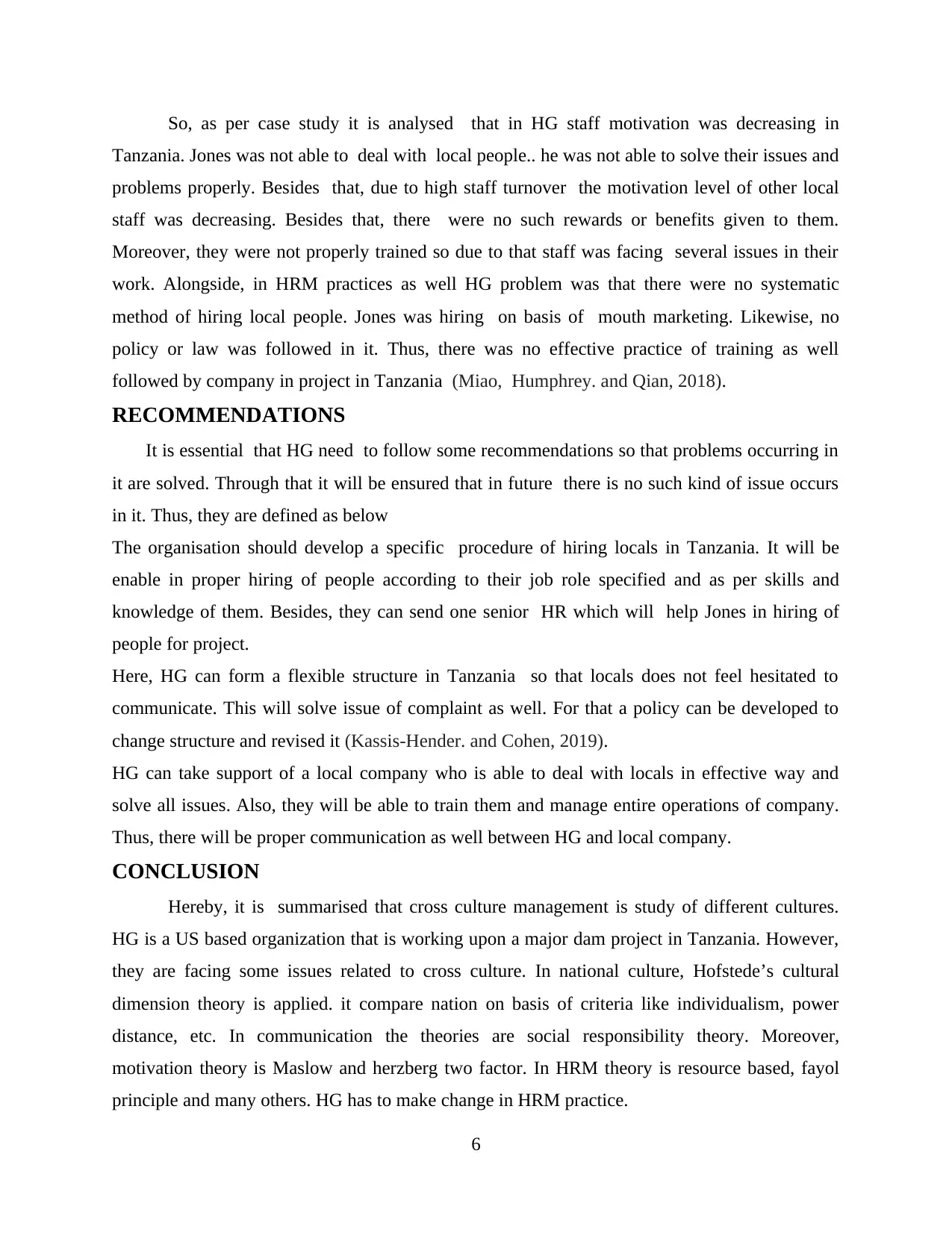
So, as per case study it is analysed that in HG staff motivation was decreasing in
Tanzania. Jones was not able to deal with local people.. he was not able to solve their issues and
problems properly. Besides that, due to high staff turnover the motivation level of other local
staff was decreasing. Besides that, there were no such rewards or benefits given to them.
Moreover, they were not properly trained so due to that staff was facing several issues in their
work. Alongside, in HRM practices as well HG problem was that there were no systematic
method of hiring local people. Jones was hiring on basis of mouth marketing. Likewise, no
policy or law was followed in it. Thus, there was no effective practice of training as well
followed by company in project in Tanzania (Miao, Humphrey. and Qian, 2018).
RECOMMENDATIONS
It is essential that HG need to follow some recommendations so that problems occurring in
it are solved. Through that it will be ensured that in future there is no such kind of issue occurs
in it. Thus, they are defined as below
The organisation should develop a specific procedure of hiring locals in Tanzania. It will be
enable in proper hiring of people according to their job role specified and as per skills and
knowledge of them. Besides, they can send one senior HR which will help Jones in hiring of
people for project.
Here, HG can form a flexible structure in Tanzania so that locals does not feel hesitated to
communicate. This will solve issue of complaint as well. For that a policy can be developed to
change structure and revised it (Kassis-Hender. and Cohen, 2019).
HG can take support of a local company who is able to deal with locals in effective way and
solve all issues. Also, they will be able to train them and manage entire operations of company.
Thus, there will be proper communication as well between HG and local company.
CONCLUSION
Hereby, it is summarised that cross culture management is study of different cultures.
HG is a US based organization that is working upon a major dam project in Tanzania. However,
they are facing some issues related to cross culture. In national culture, Hofstede’s cultural
dimension theory is applied. it compare nation on basis of criteria like individualism, power
distance, etc. In communication the theories are social responsibility theory. Moreover,
motivation theory is Maslow and herzberg two factor. In HRM theory is resource based, fayol
principle and many others. HG has to make change in HRM practice.
6
Tanzania. Jones was not able to deal with local people.. he was not able to solve their issues and
problems properly. Besides that, due to high staff turnover the motivation level of other local
staff was decreasing. Besides that, there were no such rewards or benefits given to them.
Moreover, they were not properly trained so due to that staff was facing several issues in their
work. Alongside, in HRM practices as well HG problem was that there were no systematic
method of hiring local people. Jones was hiring on basis of mouth marketing. Likewise, no
policy or law was followed in it. Thus, there was no effective practice of training as well
followed by company in project in Tanzania (Miao, Humphrey. and Qian, 2018).
RECOMMENDATIONS
It is essential that HG need to follow some recommendations so that problems occurring in
it are solved. Through that it will be ensured that in future there is no such kind of issue occurs
in it. Thus, they are defined as below
The organisation should develop a specific procedure of hiring locals in Tanzania. It will be
enable in proper hiring of people according to their job role specified and as per skills and
knowledge of them. Besides, they can send one senior HR which will help Jones in hiring of
people for project.
Here, HG can form a flexible structure in Tanzania so that locals does not feel hesitated to
communicate. This will solve issue of complaint as well. For that a policy can be developed to
change structure and revised it (Kassis-Hender. and Cohen, 2019).
HG can take support of a local company who is able to deal with locals in effective way and
solve all issues. Also, they will be able to train them and manage entire operations of company.
Thus, there will be proper communication as well between HG and local company.
CONCLUSION
Hereby, it is summarised that cross culture management is study of different cultures.
HG is a US based organization that is working upon a major dam project in Tanzania. However,
they are facing some issues related to cross culture. In national culture, Hofstede’s cultural
dimension theory is applied. it compare nation on basis of criteria like individualism, power
distance, etc. In communication the theories are social responsibility theory. Moreover,
motivation theory is Maslow and herzberg two factor. In HRM theory is resource based, fayol
principle and many others. HG has to make change in HRM practice.
6

7
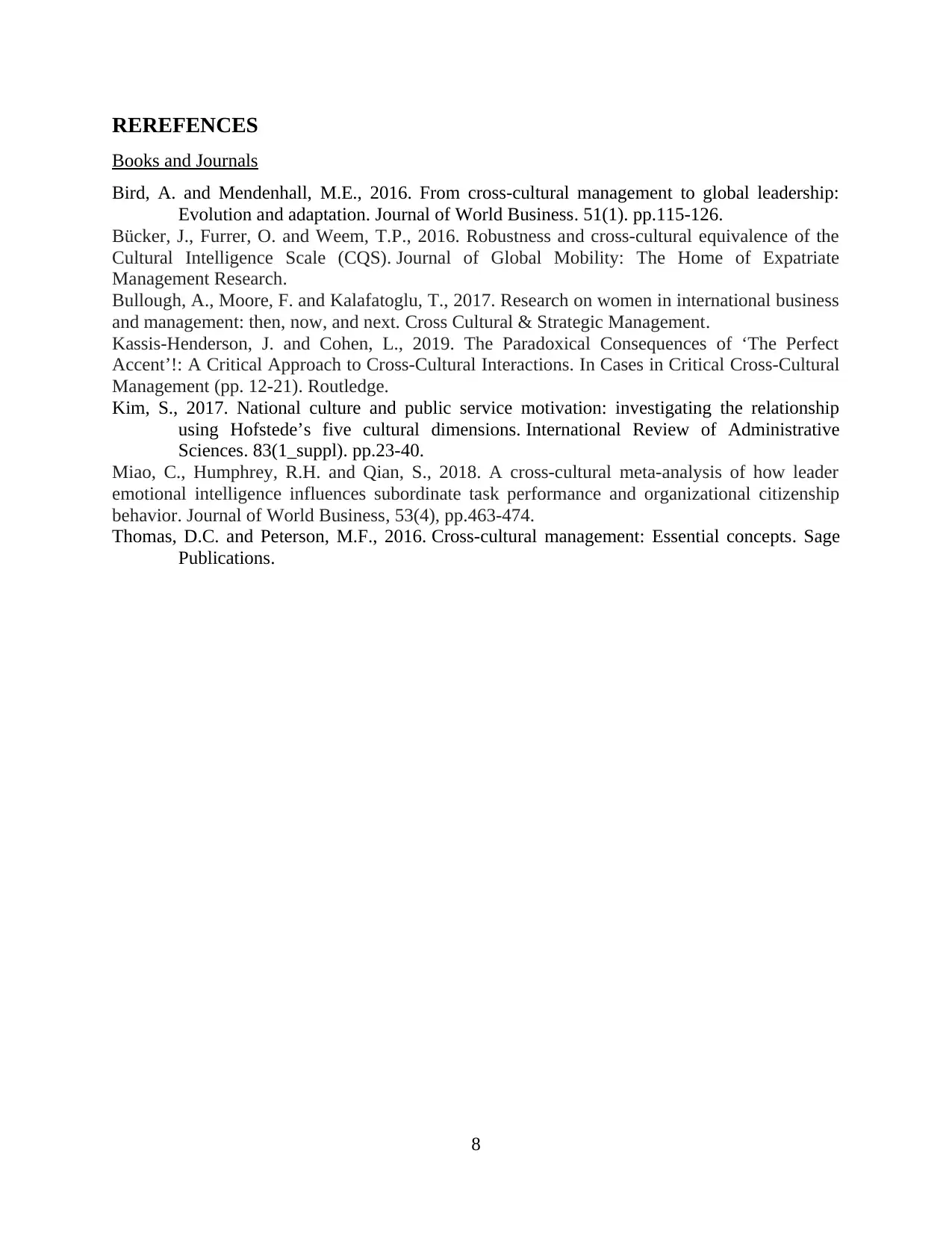
REREFENCES
Books and Journals
Bird, A. and Mendenhall, M.E., 2016. From cross-cultural management to global leadership:
Evolution and adaptation. Journal of World Business. 51(1). pp.115-126.
Bücker, J., Furrer, O. and Weem, T.P., 2016. Robustness and cross-cultural equivalence of the
Cultural Intelligence Scale (CQS). Journal of Global Mobility: The Home of Expatriate
Management Research.
Bullough, A., Moore, F. and Kalafatoglu, T., 2017. Research on women in international business
and management: then, now, and next. Cross Cultural & Strategic Management.
Kassis-Henderson, J. and Cohen, L., 2019. The Paradoxical Consequences of ‘The Perfect
Accent’!: A Critical Approach to Cross-Cultural Interactions. In Cases in Critical Cross-Cultural
Management (pp. 12-21). Routledge.
Kim, S., 2017. National culture and public service motivation: investigating the relationship
using Hofstede’s five cultural dimensions. International Review of Administrative
Sciences. 83(1_suppl). pp.23-40.
Miao, C., Humphrey, R.H. and Qian, S., 2018. A cross-cultural meta-analysis of how leader
emotional intelligence influences subordinate task performance and organizational citizenship
behavior. Journal of World Business, 53(4), pp.463-474.
Thomas, D.C. and Peterson, M.F., 2016. Cross-cultural management: Essential concepts. Sage
Publications.
8
Books and Journals
Bird, A. and Mendenhall, M.E., 2016. From cross-cultural management to global leadership:
Evolution and adaptation. Journal of World Business. 51(1). pp.115-126.
Bücker, J., Furrer, O. and Weem, T.P., 2016. Robustness and cross-cultural equivalence of the
Cultural Intelligence Scale (CQS). Journal of Global Mobility: The Home of Expatriate
Management Research.
Bullough, A., Moore, F. and Kalafatoglu, T., 2017. Research on women in international business
and management: then, now, and next. Cross Cultural & Strategic Management.
Kassis-Henderson, J. and Cohen, L., 2019. The Paradoxical Consequences of ‘The Perfect
Accent’!: A Critical Approach to Cross-Cultural Interactions. In Cases in Critical Cross-Cultural
Management (pp. 12-21). Routledge.
Kim, S., 2017. National culture and public service motivation: investigating the relationship
using Hofstede’s five cultural dimensions. International Review of Administrative
Sciences. 83(1_suppl). pp.23-40.
Miao, C., Humphrey, R.H. and Qian, S., 2018. A cross-cultural meta-analysis of how leader
emotional intelligence influences subordinate task performance and organizational citizenship
behavior. Journal of World Business, 53(4), pp.463-474.
Thomas, D.C. and Peterson, M.F., 2016. Cross-cultural management: Essential concepts. Sage
Publications.
8
1 out of 10
Related Documents
Your All-in-One AI-Powered Toolkit for Academic Success.
+13062052269
info@desklib.com
Available 24*7 on WhatsApp / Email
![[object Object]](/_next/static/media/star-bottom.7253800d.svg)
Unlock your academic potential
© 2024 | Zucol Services PVT LTD | All rights reserved.





